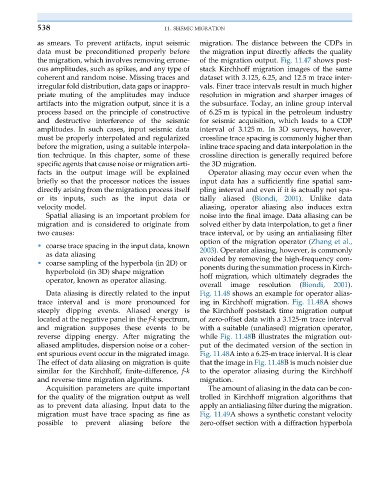Page 547 - Acquisition and Processing of Marine Seismic Data
P. 547
538 11. SEISMIC MIGRATION
as smears. To prevent artifacts, input seismic migration. The distance between the CDPs in
data must be preconditioned properly before the migration input directly affects the quality
the migration, which involves removing errone- of the migration output. Fig. 11.47 shows post-
ous amplitudes, such as spikes, and any type of stack Kirchhoff migration images of the same
coherent and random noise. Missing traces and dataset with 3.125, 6.25, and 12.5 m trace inter-
irregular fold distribution, data gaps or inappro- vals. Finer trace intervals result in much higher
priate muting of the amplitudes may induce resolution in migration and sharper images of
artifacts into the migration output, since it is a the subsurface. Today, an inline group interval
process based on the principle of constructive of 6.25 m is typical in the petroleum industry
and destructive interference of the seismic for seismic acquisition, which leads to a CDP
amplitudes. In such cases, input seismic data interval of 3.125 m. In 3D surveys, however,
must be properly interpolated and regularized crossline trace spacing is commonly higher than
before the migration, using a suitable interpola- inline trace spacing and data interpolation in the
tion technique. In this chapter, some of these crossline direction is generally required before
specific agents that cause noise or migration arti- the 3D migration.
facts in the output image will be explained Operator aliasing may occur even when the
briefly so that the processor notices the issues input data has a sufficiently fine spatial sam-
directly arising from the migration process itself pling interval and even if it is actually not spa-
or its inputs, such as the input data or tially aliased (Biondi, 2001). Unlike data
velocity model. aliasing, operator aliasing also induces extra
Spatial aliasing is an important problem for noise into the final image. Data aliasing can be
migration and is considered to originate from solved either by data interpolation, to get a finer
two causes: trace interval, or by using an antialiasing filter
option of the migration operator (Zhang et al.,
• coarse trace spacing in the input data, known
as data aliasing 2003). Operator aliasing, however, is commonly
• coarse sampling of the hyperbola (in 2D) or avoided by removing the high-frequency com-
ponents during the summation process in Kirch-
hyperboloid (in 3D) shape migration hoff migration, which ultimately degrades the
operator, known as operator aliasing.
overall image resolution (Biondi, 2001).
Data aliasing is directly related to the input Fig. 11.48 shows an example for operator alias-
trace interval and is more pronounced for ing in Kirchhoff migration. Fig. 11.48A shows
steeply dipping events. Aliased energy is the Kirchhoff poststack time migration output
located at the negative panel in the f-k spectrum, of zero-offset data with a 3.125-m trace interval
and migration supposes these events to be with a suitable (unaliased) migration operator,
reverse dipping energy. After migrating the while Fig. 11.48B illustrates the migration out-
aliased amplitudes, dispersion noise or a coher- put of the decimated version of the section in
ent spurious event occur in the migrated image. Fig. 11.48A into a 6.25-m trace interval. It is clear
The effect of data aliasing on migration is quite that the image in Fig. 11.48B is much noisier due
similar for the Kirchhoff, finite-difference, f-k to the operator aliasing during the Kirchhoff
and reverse time migration algorithms. migration.
Acquisition parameters are quite important The amount of aliasing in the data can be con-
for the quality of the migration output as well trolled in Kirchhoff migration algorithms that
as to prevent data aliasing. Input data to the apply an antialiasing filter during the migration.
migration must have trace spacing as fine as Fig. 11.49A shows a synthetic constant velocity
possible to prevent aliasing before the zero-offset section with a diffraction hyperbola

